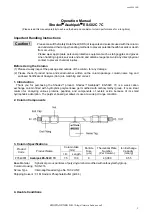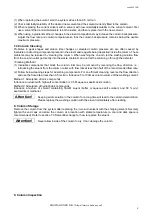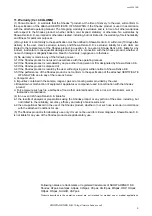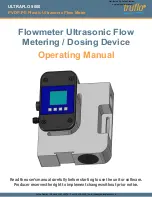
ver.220216E
SHOWA DENKO K.K. (https://www.shodex.com/)
3
(1) If possible, use the eluent for analysis to dissolve or dilute samples. If this is difficult, use a solvent which
has a composition that is as close as possible to the eluent's composition, but which fully dissolves or dilutes
the sample. When gradient elution is used, it is recommended to use the initial eluent to prepare the sample.
(2) Filter the sample solution using disposable 0.45-
μ
m filter to prevent the column from clogging or deteriorating.
(3) Recommended sample injection volume is less than 100
μ
L per column.
7. Column Usage Procedure
7.1 HPLC System Preparation
Wash entire LC system prior to the column installation, including all flow-lines and sample loop by switching the
valve, and then replace the washing solution with the eluent to be used. If desired new eluent has low
miscibility/solubility to the eluent of previous analysis, first use the eluent that is miscible/soluble to both eluents,
and then replace it with the desired eluent.
e.g. When replacing chloroform to a buffer solution, first run methanol and then introduce water, followed by the
desired buffer solution.
Attention!
· If the eluent left in the system is not compatible with the column to be used, it may damage
the column.
· A drastic change in the eluent compositions may remove substances adsorbed on the
system and they may enter and deteriorate the column.
7.2 Column Installation
(1) Connect the column to LC system by following the “flow direction arrow” (
➡
) indicated on the column name
tag.
(2) Make sure to insert the tubing all the way to the end fitting and secure it with the male nut. It is important that
there is no extra space between the tubing and the column side of the end fitting. Presence of an extra space
will let the sample to spread out and may result in wide peaks.
(3)
Set the initial flow rate at less than 0.5 mL/min and start the system. If using the column at an elevated
temperature, keep a low flow rate until the temperature of the column reaches to the set temperature, and
then gradually increase the flow rate to the desired.
Caution!
· Verify that there is no solvent leak. It may cause electronic leakage, rust, and/or chemical
injury.
Attention!
· Make sure not to let air bubbles enter the column while installing the column. The air
bubbles may damage the column.
· When restarting the system after column installation or after holding the eluent flow, start
the system at less than 0.5 mL/min. A rapid increase in pressure can damage the column.
· If the column was used at an elevated temperature, lower the flow rate to less than
0.5 mL/min at the end of analysis. Then, turn off the column oven, and let the column
temperature return to room temperature before stopping the pump. If the pump was
stopped while the eluent inside the column was still hot, as the eluent temperature
decreases, its volume also decreases. This may result in creating an empty space in the
column and deteriorates the column.
Note
· It is recommended to set the pump limiter to avoid exceeding the maximum pressure.
7.3 Solvent Exchange
























